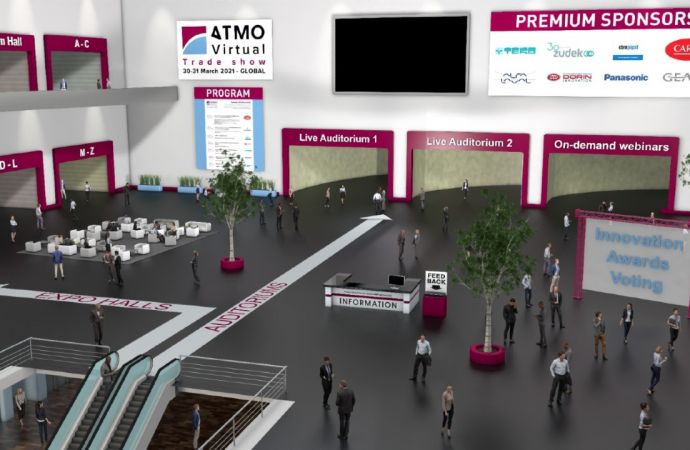At ATMOsphere Europe 2011, Jan Boone, Executive Director at Mayekawa Europe, presented a field case study of a plant retrofitted from R22 to a CO2/NH3 system. In operation since 2005, the system has proven to be highly energy efficient with calculated energy savings of 23% on energy and CO2 emissions savings of 49%.

In 2001, the contractor Cofely-GDF Suez (NL) received the request to convert a cooling-freezing plant that had been implemented in 1997 with R22 to a new and extended plant working with CO2 and NH3. Capacity and freezing temperature of the old plant ranged from 1300kW at -42°C to 2900kW at -51°C. The new plant was supposed to operate 24h per day, 7 days per week, and freezing meat by using:
The freezers need to be defrosted by using the CO2 hot gas from the plant. In addition heat recovery is required to obtain hot water for the process (55°C), the heating of floor and office space as well as dock and expedition room (35°C), bottom floor freezing rooms (12-14°C), and condensing temperature must not exceed 10°K above wet bulb temperature (authority requirement).
Besides heat recovery, the plant features following energy saving options :
High efficiency motors
Hot gas defrosting (direct and indirect)
Frequency convertors
Energy saving condensers
Results
The new plant has been completed and handed over in 2005 and has several advantages compared to a common plant operating with the synthetic refrigerant R507:
At temperatures of -51°C, CO2 is the most suitable refrigerant in a cascade system for direct use on the low temperature side, with NH3 used for the high temperature side. Thanks to the high pressure of CO2 (6-7 bar) the gas lines and machines are very small as compared to conventional systems. Because the customer's environmental license did not allow more than 2,000 kg of NH3 in the plant, ammonia was chosen for the high temperature side only.
Conclusion
The operation of the CO2/NH3 plant has proven to be significantly more efficient than a comparable plant with R507. The calculated savings amount to 23% on energy, resp. 49% on CO2 equivalent emission. In practice, it was actually possible to run the NH3 high stages at considerable lower condensing temperatures than initially designed. The average yearly condensing temperature is 25°C instead of the 32°C initial designed, resulting in a yearly energy saving of 906 MWh based on 6,000 operating hours per year. This is an increase of the COP-c of 8.7%). At an assumed price of 0.10€/kWh the energy savings translate into 90,600€.
A challenge at the time of the retrofit however was the supply and availability of high pressure components as this plant was one of the first to be realised in Europe.
Potential savings in the future
Given that meat processing needs hot water at temperatures of 70-80°C, there is great interest to add hot water production via ammonia compression heat pumps. They can use the cheaper night-time electricity for heating up the water and buffer it for use during the production process. There is plenty of heat rejected from the high stage NH3 cascade plant (over 4 mW per hour during week-production days) which can be used as heat source for the heat pumps.
- process working room chilling requiring -12°C
- plate freezers (4x550kW)
- quick freezing tunnel (1x600kW)
- a spiral freezer(1x600kW) requiring -51°C
- frozen food stores requiring -35°C
The freezers need to be defrosted by using the CO2 hot gas from the plant. In addition heat recovery is required to obtain hot water for the process (55°C), the heating of floor and office space as well as dock and expedition room (35°C), bottom floor freezing rooms (12-14°C), and condensing temperature must not exceed 10°K above wet bulb temperature (authority requirement).
Besides heat recovery, the plant features following energy saving options :
High efficiency motors
Hot gas defrosting (direct and indirect)
Frequency convertors
Energy saving condensers
Results
The new plant has been completed and handed over in 2005 and has several advantages compared to a common plant operating with the synthetic refrigerant R507:
- CO2 is a high pressure refrigerant. This means that without any problems a refrigerant temperature of -51°C can be obtained. R507 has at this temperature an evaporating pressure of 0.8 bara. As the pressure of CO2 is so much higher, the vapor lines have much smaller diameters and also the compressors are sized smaller.
- CO2 and NH3 are natural refrigerants and do not contribute or very limited to the greenhouse-gases effect.
- The new plant is significantly more efficient than a comparable plant using R507.
- The calculated savings amount to 23% on energy and 49% on emission of CO2eq.
At temperatures of -51°C, CO2 is the most suitable refrigerant in a cascade system for direct use on the low temperature side, with NH3 used for the high temperature side. Thanks to the high pressure of CO2 (6-7 bar) the gas lines and machines are very small as compared to conventional systems. Because the customer's environmental license did not allow more than 2,000 kg of NH3 in the plant, ammonia was chosen for the high temperature side only.
Conclusion
The operation of the CO2/NH3 plant has proven to be significantly more efficient than a comparable plant with R507. The calculated savings amount to 23% on energy, resp. 49% on CO2 equivalent emission. In practice, it was actually possible to run the NH3 high stages at considerable lower condensing temperatures than initially designed. The average yearly condensing temperature is 25°C instead of the 32°C initial designed, resulting in a yearly energy saving of 906 MWh based on 6,000 operating hours per year. This is an increase of the COP-c of 8.7%). At an assumed price of 0.10€/kWh the energy savings translate into 90,600€.
A challenge at the time of the retrofit however was the supply and availability of high pressure components as this plant was one of the first to be realised in Europe.
Potential savings in the future
Given that meat processing needs hot water at temperatures of 70-80°C, there is great interest to add hot water production via ammonia compression heat pumps. They can use the cheaper night-time electricity for heating up the water and buffer it for use during the production process. There is plenty of heat rejected from the high stage NH3 cascade plant (over 4 mW per hour during week-production days) which can be used as heat source for the heat pumps.
MORE INFORMATION
Related stories




